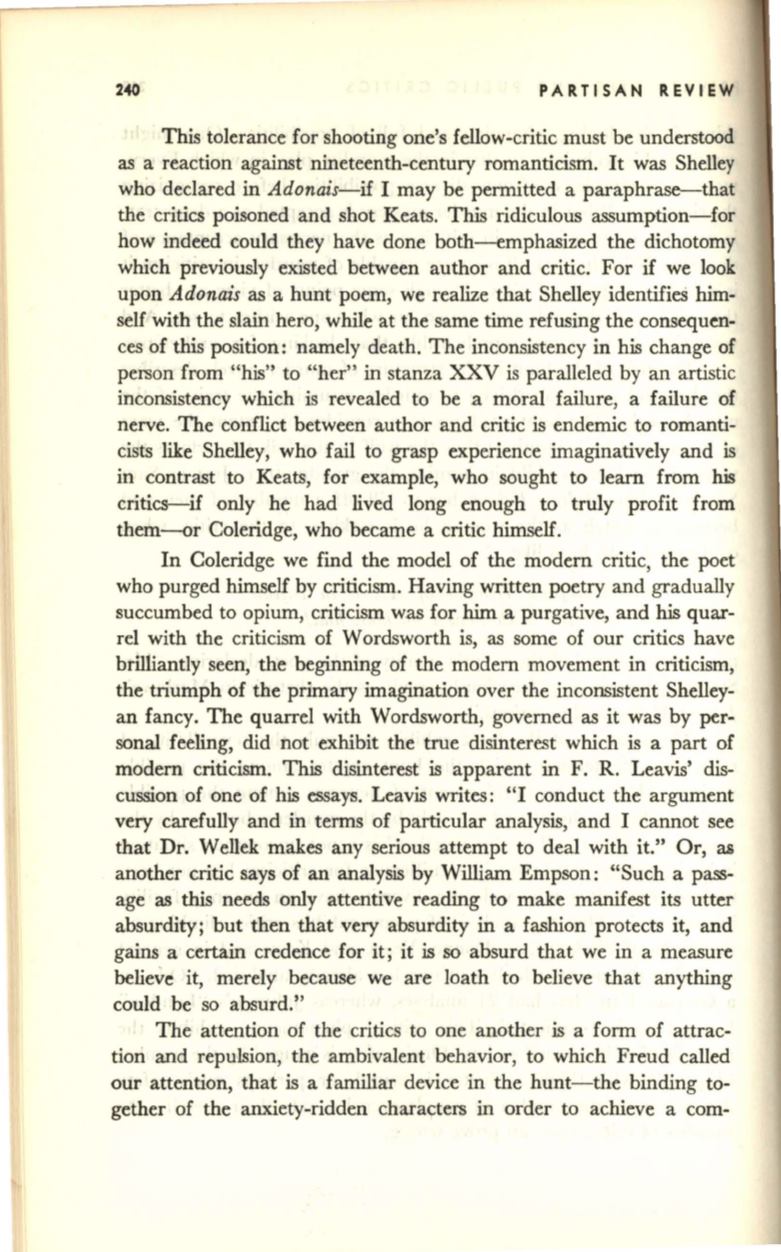
240
PARTISAN REVIEW
This tolerance for shooting one's fellow-critic must be understood
as a reaction against nineteenth-century romanticism. It was Shelley
who declared in
Adonais-if
I may be permitted a paraphrase--that
the critics poisoned and shot Keats.
This
ridiculous assumption-for
how indeed could they have done both-emphasized the dichotomy
which previously existed between author and critic. For if we look
upon
Adonais
as a hunt poem, we realize that Shelley identifieS
him–
self with the slain hero, while at the same time refusing the consequen–
ces of this position: namely death. The inconsistency in his change of
person from "his" to "her" in stanza XXV is paralleled by an artistic
inconsistency which is revealed to be a moral failure, a failure of
nerve. The conflict between author and critic is endemic to romanti–
cists like Shelley, who fail to grasp experience imaginatively and is
in contrast to Keats, for example, who sought to learn from
his
critics-if only he had lived long enough to truly profit from
them--or Coleridge, who became a critic himself.
In Coleridge we find the model of the modern critic, the poet
who purged himself by criticism. Having written poetry and gradually
succumbed to opium, criticism was for
him
a purgative, and his quar–
rel with the criticism of Wordsworth is, as some of our critics have
brilliantly seen, the beginning of the modern movement in criticism,
the triumph of the primary imagination over the inconsistent Shelley–
an fancy. The quarrel with Wordsworth, governed as it was by per–
sonal feeling, did not exhibit the true disinterest which is a part of
modern criticism.
This
disinterest is apparent in F. R. Leavis' dis–
cussion of one of
his
essays. Leavis writes: "I conduct the argument
very carefully and in terms of particular analysis, and I cannot see
that Dr. Wellek makes any serious attempt to deal with it." Or, as
another critic says of an analysis by William Empson: "Such a pass–
age as
this
needs only attentive reading to make manifest its utter
absurdity; but then that very absurdity in a fashion protects it, and
gains a certain credence for it; it is so absurd that we in a measure
believe it, merely because we are loath to believe that anything
could be so absurd."
The attention of the critics to one another is a form of attrac–
tion and repulsion, the ambivalent behavior, to which Freud called
our attention, that is a familiar device in the hunt-the binding to–
gether of the anxiety-ridden characters in order to achieve a com-


